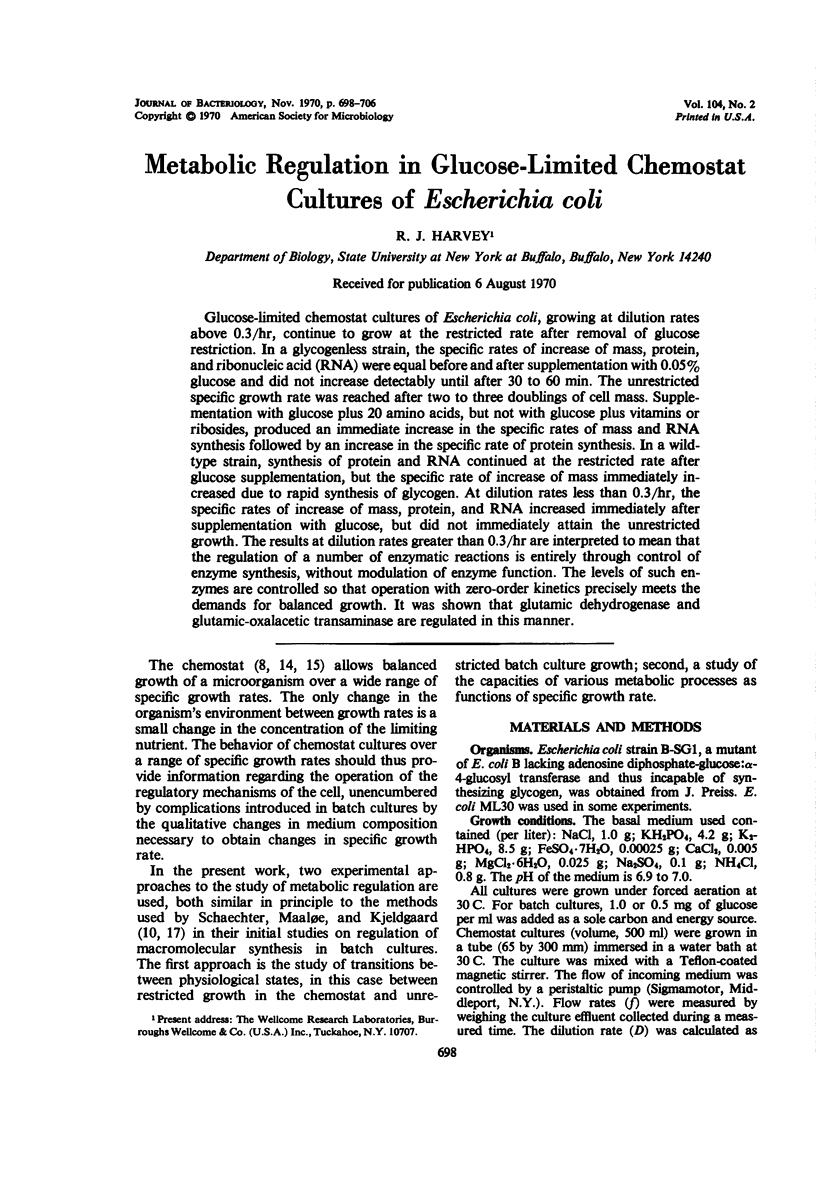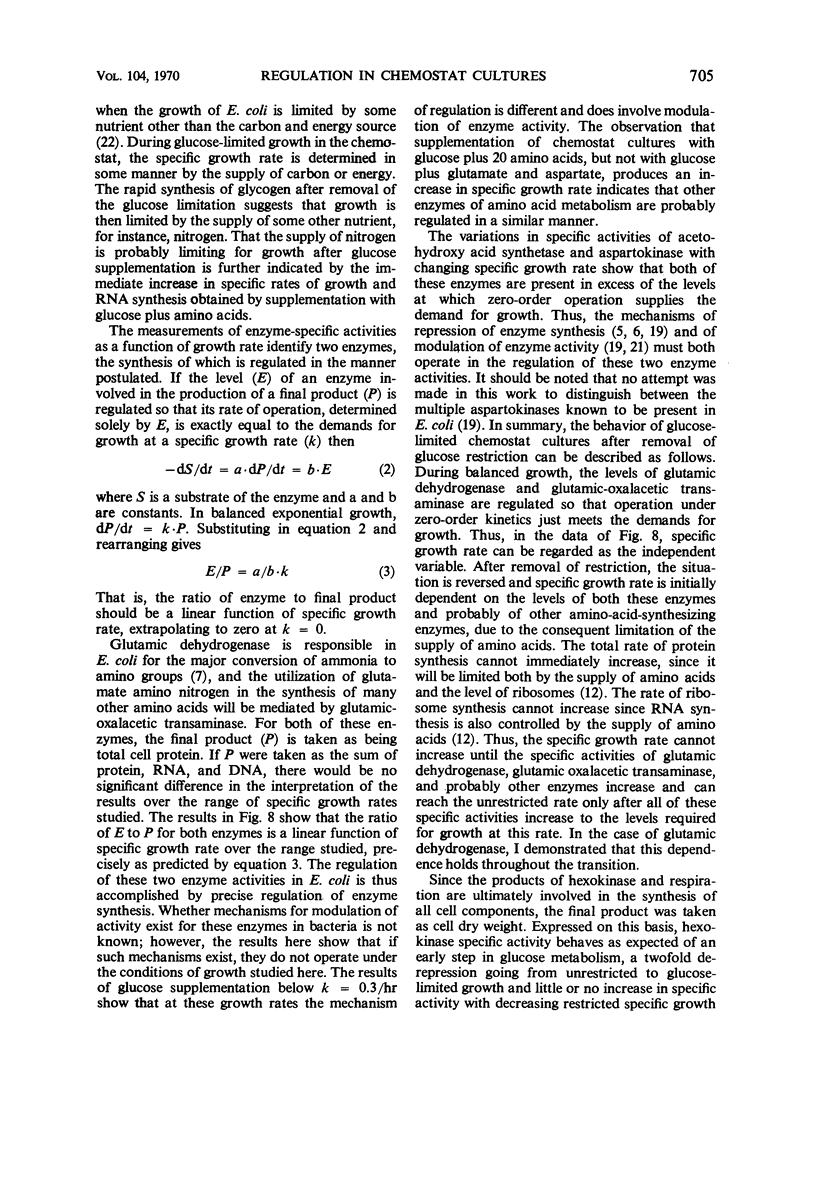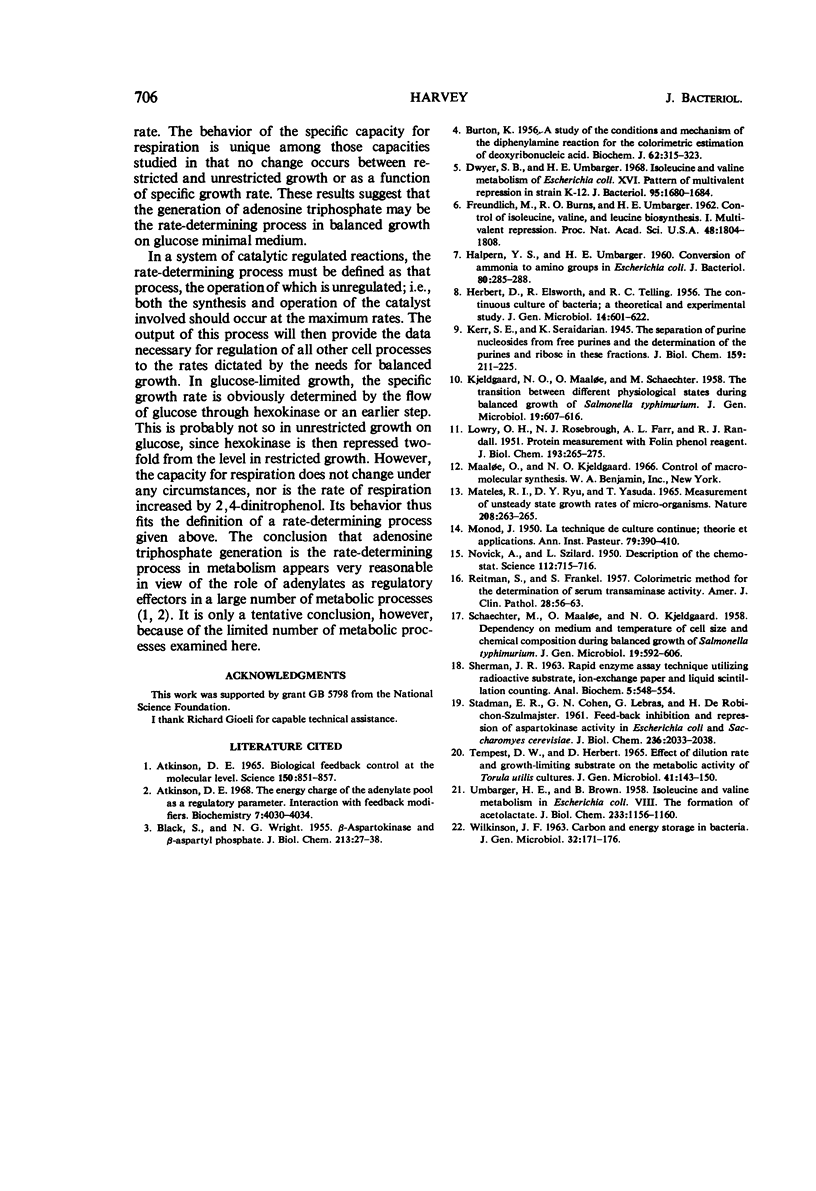Abstract
Glucose-limited chemostat cultures of Escherichia coli, growing at dilution rates above 0.3/hr, continue to grow at the restricted rate after removal of glucose restriction. In a glycogenless strain, the specific rates of increase of mass, protein, and ribonucleic acid (RNA) were equal before and after supplementation with 0.05% glucose and did not increase detectably until after 30 to 60 min. The unrestricted specific growth rate was reached after two to three doublings of cell mass. Supplementation with glucose plus 20 amino acids, but not with glucose plus vitamins or ribosides, produced an immediate increase in the specific rates of mass and RNA synthesis followed by an increase in the specific rate of protein synthesis. In a wild-type strain, synthesis of protein and RNA continued at the restricted rate after glucose supplementation, but the specific rate of increase of mass immediately increased due to rapid synthesis of glycogen. At dilution rates less than 0.3/hr, the specific rates of increase of mass, protein, and RNA increased immediately after supplementation with glucose, but did not immediately attain the unrestricted growth. The results at dilution rates greater than 0.3/hr are interpreted to mean that the regulation of a number of enzymatic reactions is entirely through control of enzyme synthesis, without modulation of enzyme function. The levels of such enzymes are controlled so that operation with zero-order kinetics precisely meets the demands for balanced growth. It was shown that glutamic dehydrogenase and glutamic-oxalacetic transaminase are regulated in this manner.
Full text
PDF








Selected References
These references are in PubMed. This may not be the complete list of references from this article.
- Atkinson D. E. Biological feedback control at the molecular level. Science. 1965 Nov 12;150(3698):851–857. doi: 10.1126/science.150.3698.851. [DOI] [PubMed] [Google Scholar]
- Atkinson D. E. The energy charge of the adenylate pool as a regulatory parameter. Interaction with feedback modifiers. Biochemistry. 1968 Nov;7(11):4030–4034. doi: 10.1021/bi00851a033. [DOI] [PubMed] [Google Scholar]
- BLACK S., WRIGHT N. G. beta-Aspartokinase and beta-aspartyl phosphate. J Biol Chem. 1955 Mar;213(1):27–38. [PubMed] [Google Scholar]
- Dwyer S. B., Umbarger H. E. Isoleucine and valine metabolism of Escherichia coli. XVI. Pattern of multivalent repression in strain K-12. J Bacteriol. 1968 May;95(5):1680–1684. doi: 10.1128/jb.95.5.1680-1684.1968. [DOI] [PMC free article] [PubMed] [Google Scholar]
- FREUNDLICH M., BURNS R. O., UMBARGER H. E. Control of isoleucine, valine, and leucine biosynthesis. I. Multivalent repression. Proc Natl Acad Sci U S A. 1962 Oct 15;48:1804–1808. doi: 10.1073/pnas.48.10.1804. [DOI] [PMC free article] [PubMed] [Google Scholar]
- HALPERN Y. S., UMBARGER H. E. Conversion of ammonia to amino groups in Escherichia coli. J Bacteriol. 1960 Sep;80:285–288. doi: 10.1128/jb.80.3.285-288.1960. [DOI] [PMC free article] [PubMed] [Google Scholar]
- HERBERT D., ELSWORTH R., TELLING R. C. The continuous culture of bacteria; a theoretical and experimental study. J Gen Microbiol. 1956 Jul;14(3):601–622. doi: 10.1099/00221287-14-3-601. [DOI] [PubMed] [Google Scholar]
- KJELDGAARD N. O., MAALOE O., SCHAECHTER M. The transition between different physiological states during balanced growth of Salmonella typhimurium. J Gen Microbiol. 1958 Dec;19(3):607–616. doi: 10.1099/00221287-19-3-607. [DOI] [PubMed] [Google Scholar]
- LOWRY O. H., ROSEBROUGH N. J., FARR A. L., RANDALL R. J. Protein measurement with the Folin phenol reagent. J Biol Chem. 1951 Nov;193(1):265–275. [PubMed] [Google Scholar]
- Mateles R. K., Ryu D. Y., Yasuda T. Measurement of unsteady state growth rates of micro-organisms. Nature. 1965 Oct 16;208(5007):263–265. doi: 10.1038/208263a0. [DOI] [PubMed] [Google Scholar]
- NOVICK A., SZILARD L. Description of the chemostat. Science. 1950 Dec 15;112(2920):715–716. doi: 10.1126/science.112.2920.715. [DOI] [PubMed] [Google Scholar]
- REITMAN S., FRANKEL S. A colorimetric method for the determination of serum glutamic oxalacetic and glutamic pyruvic transaminases. Am J Clin Pathol. 1957 Jul;28(1):56–63. doi: 10.1093/ajcp/28.1.56. [DOI] [PubMed] [Google Scholar]
- SCHAECHTER M., MAALOE O., KJELDGAARD N. O. Dependency on medium and temperature of cell size and chemical composition during balanced grown of Salmonella typhimurium. J Gen Microbiol. 1958 Dec;19(3):592–606. doi: 10.1099/00221287-19-3-592. [DOI] [PubMed] [Google Scholar]
- SHERMAN J. R. Rapid enzyme assay technique utilizing radioactive substrate, ion-exchange paper, and liquid scintillation counting. Anal Biochem. 1963 Jun;5:548–554. doi: 10.1016/0003-2697(63)90075-7. [DOI] [PubMed] [Google Scholar]
- Tempest D. W., Herbert D. Effect of dilution rate and growth-limiting substrate on the metabolic activity of Torula utilis cultures. J Gen Microbiol. 1965 Oct;41(1):143–150. doi: 10.1099/00221287-41-1-143. [DOI] [PubMed] [Google Scholar]
- UMBARGER H. E., BROWN B. Isoleucine and valine metabolism in Escherichia coli. VIII. The formation of acetolactate. J Biol Chem. 1958 Nov;233(5):1156–1160. [PubMed] [Google Scholar]
- WILKINSON J. F. CARBON AND ENERGY STORAGE IN BACTERIA. J Gen Microbiol. 1963 Aug;32:171–176. doi: 10.1099/00221287-32-2-171. [DOI] [PubMed] [Google Scholar]


